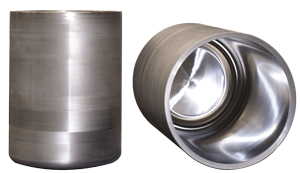- News
18 June 2012
PLANSEE exhibits ultra-smooth tungsten crucibles that extend service life and reduce cost for sapphire growth
 In booth I112 at the Display Taiwan trade show (19 June), PLANSEE of Reutte, Austria (which makes refractory metals and composite materials including pressed-sintered crucibles made of tungsten and molybdenum) is showcasing new ultra-smooth tungsten crucibles for sapphire growth.
In booth I112 at the Display Taiwan trade show (19 June), PLANSEE of Reutte, Austria (which makes refractory metals and composite materials including pressed-sintered crucibles made of tungsten and molybdenum) is showcasing new ultra-smooth tungsten crucibles for sapphire growth.
Picture: Tungsten crucible with ultra-smooth surface.
The Kyropoulos method (widely used to grow ultra-pure sapphire substrates for LEDs) involves melting a sapphire crystal in a heat-resistant crucible made from molybdenum or tungsten. A particularly critical stage during this process is when the sapphire crystal is extracted from the crucible. The easier the sapphire can be released from the crucible, the greater its yield and quality. If the surface of the crucible is too rough, the sapphire cannot be released or can only be partially released from the crucible’s wall, resulting in cracks and faults in the crystal. Also, the crucible itself is damaged and has to be reworked or replaced earlier than planned.
PLANSEE says that its more than 90 years of experience in powder metallurgy, coupled with a fully automated manufacturing process, allow it to exercise precise control over the material properties of refractory metals such as tungsten and molybdenum. To reduce the cost of sapphire growth, the firm has hence developed a special cost-saving pressed-sintered tungsten crucible with an ultra-smooth surface.
With surface roughness of less than 0.8µm, the sapphire can be extracted from the crucible without difficulty and without damaging the surface of the crucible, it is claimed. For sapphire producers, this results in less complex and expensive reworking of the surface of the crucible. The cycles run smoothly and deliver high-quality ingots, the firm adds. Also, the smooth surface is less susceptible to corrosion (caused by the aggressive melted sapphire), increasing the service life of the reusable tungsten crucibles.
In addition, crucibles with a low density and a large number of porous areas can shrink under the high process temperatures, becoming more dense during use and even becoming seriously deformed or breaking. PLANSEE says that it has finely adjusted the sintering process for the crucibles. Sintering is performed at very high temperatures and a uniform temperature distribution, giveing the crucibles a very high material density of 93% coupled with an extremely homogeneous density distribution. Even under high temperatures and rapid changes of temperature, the crucible is guaranteed to retain its shape.
Finally, contaminants in plant components can be transferred to the sapphire in a way that is detrimental to its quality. Iron, titanium and chromium are particularly critical in this respect. To ensure that only flawless sapphire comes out of the crucible, PLANSEE has adopted an ultra-clean production process. Everything from the metal powder to the finished crucibles is manufactured in-house, so every step can be carefully monitored, resulting in crucible purity exceeding 99.97%.
PLANSEE says that, currently, crucibles large enough for 35-100kg of sapphire are commonplace. Yet the industry is already considering a new generation for up to 200kg of sapphire. The firm therefore notes that its extremely large sintering plants and processing machines mean that it is already geared up for this step.
PLANSEE launches MoCu composite wafer substrate to prevent cracks in LED chips
PLANSEE Sapphire Tungsten crucibles
